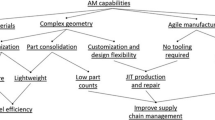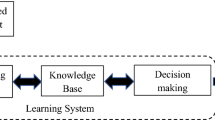Abstract
For improving manufacturing efficiency and minimizing costs, design for additive manufacturing (AM) has been accordingly proposed. The existing design for AM methods are mainly surrogate model based. Due to the increasingly available data nowadays, machine learning (ML) has been applied to medical diagnosis, image processing, prediction, classification, learning association, etc. A variety of studies have also been carried out to use machine learning for optimizing the process parameters of AM with corresponding objectives. In this paper, a ML integrated design for AM framework is proposed, which takes advantage of ML that can learn the complex relationships between the design and performance spaces. Furthermore, the primary advantage of ML over other surrogate modelling methods is the capability to model input–output relationships in both directions. That is, a deep neural network can model property–structure relationships, given structure–property input–output data. A case study was carried out to demonstrate the effectiveness of using ML to design a customized ankle brace that has a tunable mechanical performance with tailored stiffness.











Similar content being viewed by others
References
Baturynska, I. (2019). Application of machine learning techniques to predict the mechanical properties of polyamide 2200 (PA12) in additive manufacturing. Applied Sciences, 9(6), 1060. https://doi.org/10.3390/app9061060.
Baturynska, I., Semeniuta, O., & Wang, K. (2019). Application of machine learning methods to improve dimensional accuracy in additive manufacturing. In Lecture notes in electrical engineering (Vol. 484, pp. 245–252). Springer. https://doi.org/10.1007/978-981-13-2375-1_31.
Chen, H., & Zhao, Y. F. (2015). Learning algorithm based modeling and process parameters recommendation system for binder jetting additive manufacturing process. In Proceedings of the ASME design engineering technical conference (Vol. 1A–2015). American Society of Mechanical Engineers (ASME). https://doi.org/10.1115/detc2015-47627.
Chen, J., Siegler, S., & Schneck, C. D. (1988). The three-dimensional kinematics and flexibility characteristics of the human ankle and subtalar joint-part II: Flexibility characteristics. Journal of Biomechanical Engineering, 110(4), 374–385. https://doi.org/10.1115/1.3108456.
Choi, H., McDowell, D. L., Allen, J. K., Rosen, D., & Mistree, F. (2008). An inductive design exploration method for robust multiscale materials design. Journal of Mechanical Design, Transactions of the ASME. https://doi.org/10.1115/1.2829860.
Chowdhury, S., & Anand, S. (2016). Artificial neural network based geometric compensation for thermal deformation in additive manufacturing processes. In Volume 3: Joint MSEC-NAMRC symposia (p. V003T08A006). Retrieved April 10, 2018, from http://proceedings.asmedigitalcollection.asme.org/proceeding.aspx?doi=10.1115/MSEC2016-8784.
Gibson, I., Rosen, D. W., & Stucker, B. (2010). Design for additive manufacturing. In I. Gibson, D. W. Rosen, & B. Stucker (Eds.), Additive manufacturing technologies (pp. 299–332). Boston, MA: Springer. https://doi.org/10.1007/978-1-4419-1120-9_11.
Gu, J., Wang, Z., Kuen, J., Ma, L., Shahroudy, A., Shuai, B., et al. (2018). Recent advances in convolutional neural networks. Pattern Recognition, 77, 354–377. https://doi.org/10.1016/j.patcog.2017.10.013.
He, K., Zhang, X., Ren, S., & Sun, J. (2015). Delving deep into rectifiers: Surpassing human-level performance on ImageNet classification. In The IEEE international conference on computer vision (ICCV) (pp. 1026–1034).
Huang, J., Chen, Q., Jiang, H., Zou, B., Li, L., Liu, J., et al. (2020). A survey of design methods for material extrusion polymer 3D printing. Virtual and Physical Prototyping, 15(2), 148–162. https://doi.org/10.1080/17452759.2019.1708027.
Jang, K. I., Chung, H. U., Xu, S., Lee, C. H., Luan, H., Jeong, J., et al. (2015). Soft network composite materials with deterministic and bio-inspired designs. Nature Communications, 6(1), 1–11. https://doi.org/10.1038/ncomms7566.
Jiang, J., Hu, G., Li, X., Xu, X., Zheng, P., & Stringer, J. (2019a). Analysis and prediction of printable bridge length in fused deposition modelling based on back propagation neural network. Virtual and Physical Prototyping, 14(3), 253–266. https://doi.org/10.1080/17452759.2019.1576010.
Jiang, J., Weng, F., Gao, S., Stringer, J., Xu, X., & Guo, P. (2019b). A support interface method for easy part removal in direct metal deposition. Manufacturing Letters, 20, 30–33. https://doi.org/10.1016/j.mfglet.2019.04.002.
Jiang, J., Xu, X., & Stringer, J. (2018a). Support structures for additive manufacturing: A review. Journal of Manufacturing and Materials Processing, 2(4), 64. https://doi.org/10.3390/jmmp2040064.
Jiang, J., Xu, X., & Stringer, J. (2018b). A new support strategy for reducing waste in additive manufacturing. In The 48th international conference on computers and industrial engineering (CIE 48) (pp. 1–7). Auckland.
Jiang, J., Xu, X., & Stringer, J. (2019c). Effect of extrusion temperature on printable threshold overhang in additive manufacturing. In CIRP manufacturing systems conference 2019. Ljubljana.
Jiang, J., Xu, X., & Stringer, J. (2019d). Optimisation of multi-part production in additive manufacturing for reducing support waste. Virtual and Physical Prototyping, 14(3), 219–228. https://doi.org/10.1080/17452759.2019.1585555.
Jiang, J., Xu, X., & Stringer, J. (2019e). Optimization of process planning for reducing material waste in extrusion based additive manufacturing. Robotics and Computer-Integrated Manufacturing, 59, 317–325. https://doi.org/10.1016/j.rcim.2019.05.007.
Jin, K. H., McCann, M. T., Froustey, E., & Unser, M. (2017). Deep convolutional neural network for inverse problems in imaging. IEEE Transactions on Image Processing, 26(9), 4509–4522. https://doi.org/10.1109/TIP.2017.2713099.
Khanzadeh, M., Rao, P., Jafari-Marandi, R., Smith, B. K., Tschopp, M. A., & Bian, L. (2018). Quantifying geometric accuracy with unsupervised machine learning: Using self-organizing map on fused filament fabrication additive manufacturing parts. Journal of Manufacturing Science and Engineering, Transactions of the ASME. https://doi.org/10.1115/1.4038598.
Kim, S., Rosen, D. W., Witherell, P., & Ko, H. (2019). A design for additive manufacturing ontology to support manufacturability analysis. Journal of Computing and Information Science in Engineering. https://doi.org/10.1115/1.4043531.
Lao, W., Li, M., Wong, T. N., Tan, M. J., & Tjahjowidodo, T. (2020). Improving surface finish quality in extrusion-based 3D concrete printing using machine learning-based extrudate geometry control. Virtual and Physical Prototyping. https://doi.org/10.1080/17452759.2020.1713580.
Liu, W., Wang, Z., Liu, X., Zeng, N., Liu, Y., & Alsaadi, F. E. (2017). A survey of deep neural network architectures and their applications. Neurocomputing, 234, 11–26. https://doi.org/10.1016/j.neucom.2016.12.038.
Li, Z., Zhang, Z., Shi, J., & Wu, D. (2019). Prediction of surface roughness in extrusion-based additive manufacturing with machine learning. Robotics and Computer-Integrated Manufacturing, 57, 488–495. https://doi.org/10.1016/j.rcim.2019.01.004.
Lu, Z. L., Li, D. C., Lu, B. H., Zhang, A. F., Zhu, G. X., & Pi, G. (2010). The prediction of the building precision in the laser engineered net shaping process using advanced networks. Optics and Lasers in Engineering, 48(5), 519–525. https://doi.org/10.1016/j.optlaseng.2010.01.002.
Mahapatra, S. S., & Sood, A. K. (2012). Bayesian regularization-based Levenberg–Marquardt neural model combined with BFOA for improving surface finish of FDM processed part. International Journal of Advanced Manufacturing Technology, 60(9–12), 1223–1235. https://doi.org/10.1007/s00170-011-3675-x.
Malak, R. J., Aughenbaugh, J. M., & Paredis, C. J. J. (2009). Multi-attribute utility analysis in set-based conceptual design. CAD Computer Aided Design, 41(3), 214–227. https://doi.org/10.1016/j.cad.2008.06.004.
Matthews, J., Klatt, T., Morris, C., Seepersad, C. C., Haberman, M., & Shahan, D. (2016). Hierarchical design of negative stiffness metamaterials using a Bayesian network classifier. Journal of Mechanical Design, Transactions of the ASME. https://doi.org/10.1115/1.4032774.
Mohamed, O. A., Masood, S. H., & Bhowmik, J. L. (2017). Influence of processing parameters on creep and recovery behavior of FDM manufactured part using definitive screening design and ANN. Rapid Prototyping Journal, 23(6), 998–1010. https://doi.org/10.1108/RPJ-12-2015-0198.
Morris, C., Bekker, L., Haberman, M. R., & Seepersad, C. C. (2018). Design exploration of reliably manufacturable materials and structures with applications to negative stiffness metamaterials and microstereolithography. Journal of Mechanical Design, Transactions of the ASME. https://doi.org/10.1115/1.4041251.
Negi, S., & Sharma, R. K. (2016). Study on shrinkage behaviour of laser sintered PA 3200GF specimens using RSM and ANN. Rapid Prototyping Journal, 22(4), 645–659. https://doi.org/10.1108/RPJ-08-2014-0090.
Pacheco, J. E., Amon, C. H., & Finger, S. (2003). Bayesian surrogates applied to conceptual stages of the engineering design process. Journal of Mechanical Design, Transactions of the ASME, 125(4), 664–672. https://doi.org/10.1115/1.1631580.
Rosen, D. W. (2007). Computer-aided design for additive manufacturing of cellular structures. Computer-Aided Design and Applications, 4(5), 585–594. https://doi.org/10.1080/16864360.2007.10738493.
Rosen, D. W. (2014). Research supporting principles for design for additive manufacturing. Virtual and Physical Prototyping, 9(4), 225–232. https://doi.org/10.1080/17452759.2014.951530.
Samuel, A. L. (1959). Some studies in machine learning using the game of checkers—IBM journals & magazine. IBM Journal of Research and Development, 3(3), 210–229.
Shahan, D. W., & Seepersad, C. C. (2012). Bayesian network classifiers for set-based collaborative design. Journal of Mechanical Design, Transactions of the ASME. https://doi.org/10.1115/1.4006323.
Siegler, S., Chen, J., & Schneck, C. D. (1988). The three-dimensional kinematics and flexibility characteristics of the human ankle and subtalar joints—Part I: Kinematics. Journal of Biomechanical Engineering, 110(4), 364–373. https://doi.org/10.1115/1.3108455.
Thiele, F., Schuhmacher, S., Schwaller, C., Plüss, S., Rhiner, J., List, R., et al. (2018). Restrictions in the ankle sagittal- and frontal-plane range of movement during simulated walking with different types of orthoses. Journal of Functional Morphology and Kinesiology, 3(2), 21. https://doi.org/10.3390/jfmk3020021.
Thompson, M. K., Moroni, G., Vaneker, T., Fadel, G., Campbell, R. I., Gibson, I., et al. (2016). Design for additive manufacturing: Trends, opportunities, considerations, and constraints. CIRP Annals—Manufacturing Technology, 65(2), 737–760. https://doi.org/10.1016/j.cirp.2016.05.004.
Tootooni, M. S., Dsouza, A., Donovan, R., Rao, P. K., Kong, Z. J., & Borgesen, P. (2017). Classifying the dimensional variation in additive manufactured parts from laser-scanned three-dimensional point cloud data using machine learning approaches. Journal of Manufacturing Science and Engineering, Transactions of the ASME. https://doi.org/10.1115/1.4036641.
Unal, M., Miller, S. W., Chhabra, J. P. S., Warn, G. P., Yukish, M. A., & Simpson, T. W. (2017). A sequential decision process for the system-level design of structural frames. Structural and Multidisciplinary Optimization, 56(5), 991–1011. https://doi.org/10.1007/s00158-017-1697-1.
Vijayaraghavan, V., Garg, A., Lam, J. S. L., Panda, B., & Mahapatra, S. S. (2015). Process characterisation of 3D-printed FDM components using improved evolutionary computational approach. International Journal of Advanced Manufacturing Technology, 78(5–8), 781–793. https://doi.org/10.1007/s00170-014-6679-5.
Wei, H., Shirinzadeh, B., Niu, X., Zhang, J., Li, W., & Simeone, A. (2020). Study of the hinge thickness deviation for a 316L parallelogram flexure mechanism fabricated via selective laser melting. Journal of Intelligent Manufacturing. https://doi.org/10.1007/s10845-020-01621-x.
Weiss, L. E., Amon, C. H., Finger, S., Miller, E. D., Romero, D., Verdinelli, I., et al. (2005). Bayesian computer-aided experimental design of heterogeneous scaffolds for tissue engineering. CAD Computer Aided Design, 37(11), 1127–1139. https://doi.org/10.1016/j.cad.2005.02.004.
Xiong, J., Zhang, G., Hu, J., & Wu, L. (2014). Bead geometry prediction for robotic GMAW-based rapid manufacturing through a neural network and a second-order regression analysis. Journal of Intelligent Manufacturing, 25(1), 157–163. https://doi.org/10.1007/s10845-012-0682-1.
Xiong, J., Zhang, Y., & Pi, Y. (2020). Control of deposition height in WAAM using visual inspection of previous and current layers. Journal of Intelligent Manufacturing. https://doi.org/10.1007/s10845-020-01634-6.
Xiong, Y., Duong, P. L. T., Wang, D., Park, S. I., Ge, Q., Raghavan, N., et al. (2019). Data-driven design space exploration and exploitation for design for additive manufacturing. Journal of Mechanical Design, Transactions of the ASME. https://doi.org/10.1115/1.4043587.
Zhang, W., Mehta, A., Desai, P. S., & Fred Higgs III, C. (2017). Machine learning enabled powder spreading process map for metal additive manufacturing (AM). In Solid freeform fabrication 2017: Proceedings of the 28th annual international solid freeform fabrication symposium (pp. 1235–1249).
Zhao, Y., Sun, J., Gupta, M. M., Moody, W., Laverty, W. H., & Zhang, W. (2017). Developing a mapping from affective words to design parameters for affective design of apparel products. Textile Research Journal, 87(18), 2224–2232. https://doi.org/10.1177/0040517516669072.
Acknowledgements
This research was funded by Digital Manufacturing and Design (DManD) Research Center at the Singapore University of Technology and Design supported by the Singapore National Research Foundation.
Author information
Authors and Affiliations
Corresponding author
Additional information
Publisher's Note
Springer Nature remains neutral with regard to jurisdictional claims in published maps and institutional affiliations.
Rights and permissions
About this article
Cite this article
Jiang, J., Xiong, Y., Zhang, Z. et al. Machine learning integrated design for additive manufacturing. J Intell Manuf 33, 1073–1086 (2022). https://doi.org/10.1007/s10845-020-01715-6
Received:
Accepted:
Published:
Issue Date:
DOI: https://doi.org/10.1007/s10845-020-01715-6




